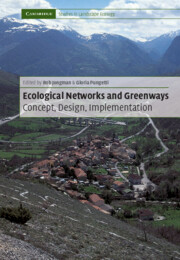Book contents
- Frontmatter
- Contents
- List of contributors
- Foreword
- Preface
- Acknowledgements
- 1 Introduction: ecological networks and greenways
- 2 The context and concept of ecological networks
- 3 Greenways in the USA: theory, trends and prospects
- 4 Ecological functioning of ecological networks: a species perspective
- 5 Impacts of roads on ecological networks and integration of conservation and transportation planning: Florida as a case study
- 6 Ecological corridors on a European scale: a typology and identification of target species
- 7 Planning the future landscape between nature and culture
- 8 From models to reality: design and implementation process
- 9 Design of the Pan-European Ecological Network: a national level attempt
- 10 Ecological ‘black spots’ within the ecological network: an improved design for rural road network amelioration
- 11 An ecological network for the Milan region based on focal species
- 12 Connecting corridors: implementing metropolitan greenway networks in North America
- 13 The Florida Statewide Greenways Project: its realisation and political context
- 14 The ecological network development in the Yungas, Argentina: planning, economic and social aspects
- 15 The river corridor of the Guadiamar
- 16 Conclusions: into the twenty-first century
- References
- Index
11 - An ecological network for the Milan region based on focal species
Published online by Cambridge University Press: 29 December 2009
- Frontmatter
- Contents
- List of contributors
- Foreword
- Preface
- Acknowledgements
- 1 Introduction: ecological networks and greenways
- 2 The context and concept of ecological networks
- 3 Greenways in the USA: theory, trends and prospects
- 4 Ecological functioning of ecological networks: a species perspective
- 5 Impacts of roads on ecological networks and integration of conservation and transportation planning: Florida as a case study
- 6 Ecological corridors on a European scale: a typology and identification of target species
- 7 Planning the future landscape between nature and culture
- 8 From models to reality: design and implementation process
- 9 Design of the Pan-European Ecological Network: a national level attempt
- 10 Ecological ‘black spots’ within the ecological network: an improved design for rural road network amelioration
- 11 An ecological network for the Milan region based on focal species
- 12 Connecting corridors: implementing metropolitan greenway networks in North America
- 13 The Florida Statewide Greenways Project: its realisation and political context
- 14 The ecological network development in the Yungas, Argentina: planning, economic and social aspects
- 15 The river corridor of the Guadiamar
- 16 Conclusions: into the twenty-first century
- References
- Index
Summary
Introduction
The Milan region is one of the most urbanised areas in southern Europe. In many anthropogenic temperate landscapes, such as the lowland of north Milan, most remaining natural or semi-natural habitat fragments consist of lowland forest. The land is highly fragmented and nature is under severe pressure from intensive land use. Many functions compete for the same land and the environment is deteriorating. Here, the main problem at present is not to conserve rare or endangered species – they are gone anyway – but rather to reverse the process of deterioration by establishing a restoration trend. This may well use the requirements of focal species to develop large-scale models and management guidelines to be applied to selected conservation areas (Lambeck 1997). In the lowland of Northern Italy, the Povalley, the natural landscape was represented by broad-leaved forest. Therefore, it may be assumed that nature conservation in this region largely coincides with conservation and reconnection of forest remnants.
The objective of this chapter is to present the applicability of focal species for developing an ecological network as a strategy for nature conservation and multi-functional land use in fragmented landscapes. Because of its urbanised and multi-functional land use, the Milan northern lowland has been used as a pilot study area (Bani et al. 2002). In addition to the forest ecological network implementation, we also present (a) an approach for wider-scale identification of forest core areas and (b) a tentative approach for an agricultural ecological network.
- Type
- Chapter
- Information
- Ecological Networks and GreenwaysConcept, Design, Implementation, pp. 188 - 199Publisher: Cambridge University PressPrint publication year: 2004
- 2
- Cited by



